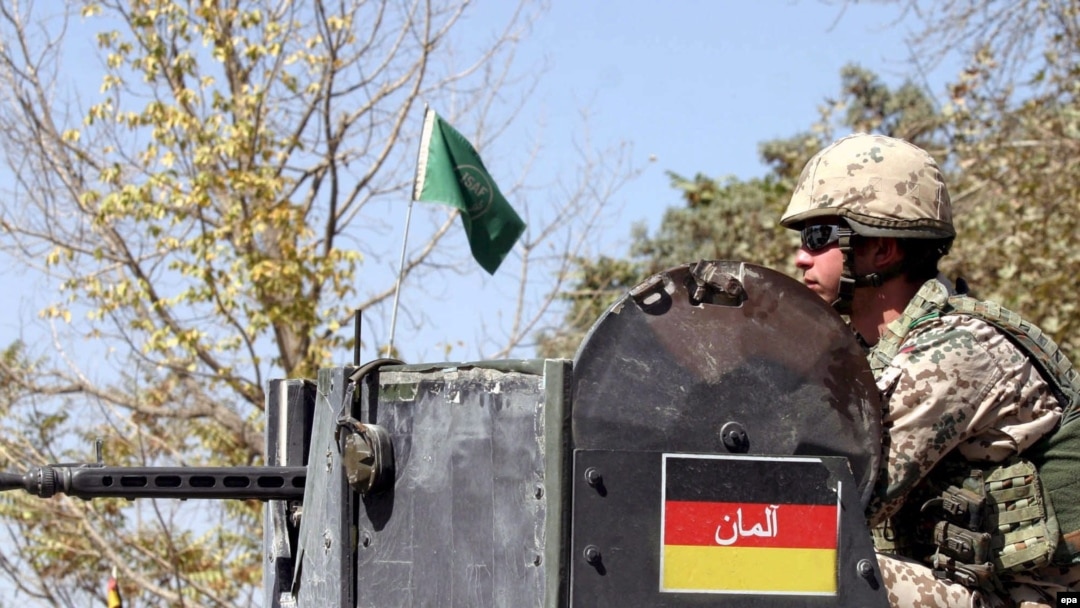A German ISAF soldier on patrol in Kabul on October 6 (epa)
WASHINGTON, October 6, 2006 (RFE/RL) -- NATO's International Security Assistance Force (ISAF) assumed command of 14 eastern and central provinces on October 5, slightly ahead of the schedule it set for itself in July. The unification of command of the majority of military forces stationed in Afghanistan has been hailed as a sign of commitment to that country by NATO.
When NATO expanded ISAF's area of operation to southern Afghanistan in July, it also announced its intention to assume full command of virtually all international troops there by the end of 2006 -- dubbed "Stage 4 expansion." The early implementation of ISAF's Stage 4 expansion is related to the unexpected resilience of the neo-Taliban and fellow guerrillas opposing ISAF in the south and the U.S.-led coalition forces in eastern and northeastern Afghanistan.
The neo-Taliban resurgence can be partly attributed to a perception that NATO's Stage 3 expansion signaled a reduction of the military commitment by the United States to Afghanistan. That assumption was coupled with the notion that NATO was a weaker and wider target that -- if threatened -- would find some members inclining toward withdrawal from Afghanistan.
Perceived Divide
The neo-Taliban and, ironically, some European voices have spoken of the United States and NATO as distinct entities. The perception is perhaps based in part on Washington's hesitation to unite the commands of the coalition forces and of ISAF -- a result of long-standing U.S. reluctance to place its troops under foreign command.
As part of the Stage 4 expansion, NATO-ISAF has taken command of around 10,000 U.S. troops.
The commander of coalition forces, U.S. Lieutenant General Karl Eikenberry, has said a "key point to remember" about the ISAF's expansion "is that the United States maintains its full commitment to Afghanistan." Seemingly to dispel doubts about U.S.-NATO relations or his country's role in Afghanistan, commander Eikenberry added that as "a NATO member, the United States will remain by far the single-largest contributor of troops and military capability" within ISAF.
With this latest expansion, ISAF finds itself in charge of approximately 31,000 troops from 37 NATO and non-NATO states. In addition to ISAF forces, the United States will continue to have around 8,000 troops conducting counterterrorism operations and providing support for the formation, training, and equipping of the Afghan National Army.
Contradictory Message?
Washington's decision to leave nearly half of its forces stationed in Afghanistan outside ISAF command is arguably illustrative of some of the contradictions in strategic views among some NATO member states regarding their forces' mandates.
British Lieutenant General David Richards currently commands ISAF forces in Afghanistan. During the ceremonies in Kabul marking the ISAF expansion on October 5, Richards called it "a historic day for both Afghanistan and NATO." He added that it "illustrates the enduring commitment of NATO and its international partners to the future of [a] great country."
The fact that ISAF is NATO's largest ground operation since the alliance was established in 1949 lends weight to Richards' comments.
But the ultimate goal of NATO's commitment could remain elusive unless member states -- particularly the economic and military powerhouses -- share a common view on the nature of the mission.
That position arguably should view the current mandate as counterinsurgency, or counterterrorism; robust counternarcotics efforts to help establish law and order; and greater familiarity with Afghan society and the related sensitivities.
The neo-Taliban resurgence can be partly attributed to a perception that NATO's Stage 3 expansion signaled a reduction of the military commitment by the United States to Afghanistan. That assumption was coupled with the notion that NATO was a weaker and wider target that -- if threatened -- would find some members inclining toward withdrawal from Afghanistan.
Perceived Divide
The neo-Taliban and, ironically, some European voices have spoken of the United States and NATO as distinct entities. The perception is perhaps based in part on Washington's hesitation to unite the commands of the coalition forces and of ISAF -- a result of long-standing U.S. reluctance to place its troops under foreign command.
As part of the Stage 4 expansion, NATO-ISAF has taken command of around 10,000 U.S. troops.
The commander of coalition forces, U.S. Lieutenant General Karl Eikenberry, has said a "key point to remember" about the ISAF's expansion "is that the United States maintains its full commitment to Afghanistan." Seemingly to dispel doubts about U.S.-NATO relations or his country's role in Afghanistan, commander Eikenberry added that as "a NATO member, the United States will remain by far the single-largest contributor of troops and military capability" within ISAF.
With this latest expansion, ISAF finds itself in charge of approximately 31,000 troops from 37 NATO and non-NATO states. In addition to ISAF forces, the United States will continue to have around 8,000 troops conducting counterterrorism operations and providing support for the formation, training, and equipping of the Afghan National Army.
Contradictory Message?
Washington's decision to leave nearly half of its forces stationed in Afghanistan outside ISAF command is arguably illustrative of some of the contradictions in strategic views among some NATO member states regarding their forces' mandates.
British Lieutenant General David Richards currently commands ISAF forces in Afghanistan. During the ceremonies in Kabul marking the ISAF expansion on October 5, Richards called it "a historic day for both Afghanistan and NATO." He added that it "illustrates the enduring commitment of NATO and its international partners to the future of [a] great country."
The fact that ISAF is NATO's largest ground operation since the alliance was established in 1949 lends weight to Richards' comments.
But the ultimate goal of NATO's commitment could remain elusive unless member states -- particularly the economic and military powerhouses -- share a common view on the nature of the mission.
That position arguably should view the current mandate as counterinsurgency, or counterterrorism; robust counternarcotics efforts to help establish law and order; and greater familiarity with Afghan society and the related sensitivities.


